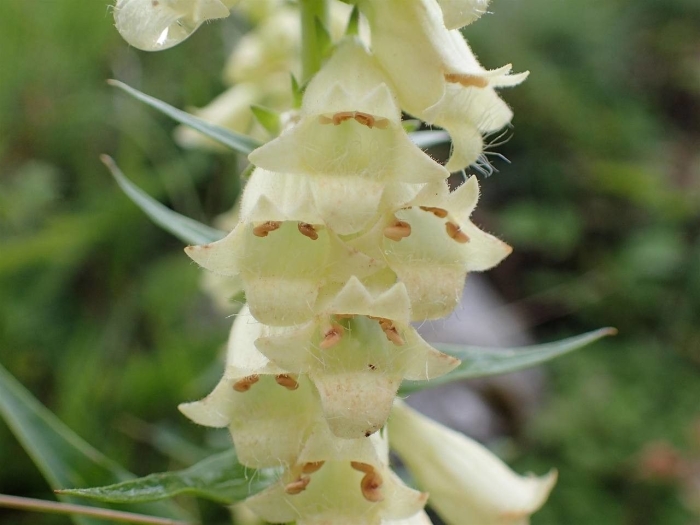Small Yellow Foxglove
(Digitalis lutea)
Small Yellow Foxglove (Digitalis lutea)
/
/

Yoan MARTIN
CC BY-SA 4.0
Image By:
Yoan MARTIN
Recorded By:
Copyright:
CC BY-SA 4.0
Copyright Notice:
Photo by: Yoan MARTIN | License Type: CC BY-SA 4.0 | License URL: https://creativecommons.org/licenses/by-sa/4.0/ | Attribution: Yoan MARTIN (cc-by-sa) | Rights Holder: Yoan MARTIN | Publisher: PlantNet | Date Created: 2017-06-30T22:00Z | Title: Digitalis lutea L.: habit | Notes: |

















































Estimated Native Range
Summary
Digitalis lutea, commonly known as Small Yellow Foxglove, is a short-lived herbaceous perennial or biennial evergreen herb native to open woodlands and forest clearings in Western Europe. It typically grows to 1 m (3.3 ft) tall and is characterized by its rosettes of lance-shaped leaves and slender spikes of tubular yellow flowers, each with intriguing brown spots inside the corolla. These flowers bloom in late spring and early summer, with sporadic flowering potentially continuing into autumn. The blooms are modestly showy and attract pollinators such as bees.
Small Yellow Foxglove is valued for its charming flowers and its ability to naturalize in the garden, often self-sowing to create natural drifts. It has earned the Royal Horticultural Society’s Award of Garden Merit, indicating its reliability and performance in gardens. This plant is suitable for border plantings, woodland gardens, and cottage gardens. It prefers partial shade but can tolerate full sun if the soil remains moist. It is adaptable to a range of soil types, provided they have good drainage. While generally easy to maintain, it can be susceptible to crown rot in overly wet conditions and may require staking if grown in very fertile soils that promote lush growth. Caution is advised as all parts of the plant are toxic if ingested, and it should be handled with care due to its digitalin content.CC BY-SA 4.0
Small Yellow Foxglove is valued for its charming flowers and its ability to naturalize in the garden, often self-sowing to create natural drifts. It has earned the Royal Horticultural Society’s Award of Garden Merit, indicating its reliability and performance in gardens. This plant is suitable for border plantings, woodland gardens, and cottage gardens. It prefers partial shade but can tolerate full sun if the soil remains moist. It is adaptable to a range of soil types, provided they have good drainage. While generally easy to maintain, it can be susceptible to crown rot in overly wet conditions and may require staking if grown in very fertile soils that promote lush growth. Caution is advised as all parts of the plant are toxic if ingested, and it should be handled with care due to its digitalin content.CC BY-SA 4.0
Plant Description
- Plant Type: Herb
- Height: 1.5-2 feet
- Width: 0.8-1 feet
- Growth Rate: Moderate
- Flower Color: Yellow, Cream
- Flowering Season: Spring, Summer
- Leaf Retention: Evergreen
Growth Requirements
- Sun: Full Sun, Part Shade
- Water: Medium
- Drainage: Slow, Medium, Fast
Common Uses
Bee Garden, Bird Garden, Butterfly Garden, Deer Resistant, Drought Tolerant, Hummingbird Garden, Low Maintenance, Rabbit Resistant, Salt Tolerant
Natural Habitat
Open woodlands and forest clearings in Western Europe
Other Names
Common Names: Straw Foxglove, Yellow Foxglove, Straw Foxglove, Gul Fingerbøl, Gelber Fingerhut, Digitale Jaune, Digitale À Petites Fleurs, Petite Digitale, Gul Revebjelle, Geel Vingerhoedskruid
Scientific Names: , Digitalis lutea, Digitalis micrantha, Digitalis lutea var. hirsuta, Digitalis aurea, Digitalis fontanesii, Digitalis guellii, Digitalis argyrostigma, Digitalis lutea var. bracteata, Digitalis lutea var. ciliata
GBIF Accepted Name: Digitalis lutea L.